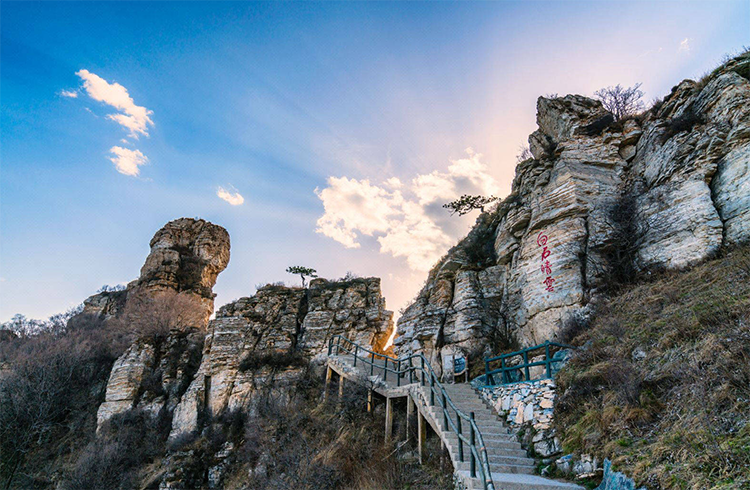Glass Skywalk at Baishi Mountain: Explore China’s White Marble Peak Forest
Introduction:
When a white ridge rises from the foothills of the Taihang Mountains in Laiyuan County, Hebei, nature sculpts what many call a “Northern Huangshan.” Baishi Mountain (White Stone Mountain), built largely of gleaming white marble, forms a dramatic peak-forest often shrouded in mist. Summers stay refreshingly cool—around 21°C—making it a cloud-top escape. Touch billion-year-old glacial scars, walk a vertigo-inducing glass skywalk, or witness the legendary multicolored “Buddha’s light” at Foguang Peak. This 5A-rated scenic area blends geological spectacle with cultural history, waiting for adventurous travelers.
1. World-class geological textbook: the birth of the marble peak forest
Baishi Mountain is rare—China’s only marble peak-forest—and its origin reads like a geology textbook. Two hundred million years ago this was a shallow sea. Limestone sediments were uplifted by tectonic forces, then sculpted by glaciation, weathering, and erosion into the knife-cut ridges and spires you see today. Foguang Peak reaches 2,096 meters; the iconic Twin Hero Stones stand like two giants, their vertical joints still bearing traces of ancient earthquakes.
Geology enthusiasts will want to study the exposed palaeoweathering crusts and glacial striations—rock cross-sections that record Quaternary ice ages. Interpretive signs around the park explain these features, and several interactive field-learning stations make scientific exploration vivid and hands-on.
2. Four-season wonders: from cloud seas and Buddha’s light to icy crystal palaces
Baishi’s weather changes rapidly, creating the local saying: “One mountain, four seasons; ten miles, different skies.”
– Spring–Summer (May–September): Average temperatures hover around 21°C, ideal for a cool summer retreat. After rain the valleys fill with a rolling sea of clouds; on clear mornings, stand on Foguang Peak with the sun at your back and you may see your shadow encircled by a rainbow—the rare optical spectacle called the “Buddha’s light.”
– Autumn–Winter (October–April): Autumn paints the gullies crimson with maple; winter ice crystals turn the mountain into a glassy palace. Visitor numbers fall off, offering quiet access to the snow-laced Great Wall remains.
3. An experience menu of adrenaline and meditation
– Cliff challenges: At about 1,600 meters elevation, the glass skywalk juts 120 meters along a sheer cliff, with a thousand-meter drop below. For bigger thrills try the “Flying Squirrel Gorge” aerial cable—soaring across the chasm feels like flying.
– Cultural hikes: Ming-dynasty Great Wall ruins snake along the ridgeline, and the remaining beacon towers and walls tell a story of past conflicts. We recommend the Jiucaiyuan–Twin Hero Stones–Foguang Peak loop (around 4 hours) to combine geology, history, and a chance to see wild Taihang macaques.
– Slow nature: Multiple viewing platforms with telescopes invite birdwatching—look for rare species like the red-bellied pheasant. If you stay overnight at a mountaintop hotel, you can join a star-photography talk after dark.

4. Practical travel tips: how to reach this mountain refuge
– Getting there: From Beijing West Station take a high-speed train to Laiyuan Station (about 1.5 hours), then the park shuttle bus (30 minutes). By car, navigate to “Baishi Mountain East Gate” via the Jingkun Expressway and Zhangshi Expressway—roughly a 3-hour drive.
– Tickets and bookings: Peak season (April–October) ticket price is 135 CNY including the sightseeing bus; the glass skywalk has an additional 10 CNY fee. Book tickets on the official site in advance and avoid weekend crowds when possible.
– Where to stay: Shangyunjian Hotel on the summit offers windows opening directly to the cloud sea. Laiyuan town at the mountain’s base has affordable guesthouses serving local Taihang dishes like iron-pot braised goose.
5. Details you shouldn’t miss
– Accessibility: A cable car runs from the east gate to Jiucaiyuan, but the glass skywalk area requires steep steps—elderly visitors should assess their fitness before attempting the climb.
– Multilingual services: Park maps include Chinese-English labels, but guided tours are currently only in Chinese. Audio guides are available for rent (deposit 200 CNY).
– Hidden gem: Enter before 6:00 a.m. and you might witness the “ink-wash Taiji” spectacle—sunrise and cloud-sea choreography that looks like a traditional brush painting come to life.

Conclusion:
Baishi Mountain challenges the stereotype that northern China lacks dramatic peaks. Here, monumental geology, layered history, and human ingenuity meet. Whether you seek an adrenaline cliff adventure, a cool summer escape among the clouds, or a contemplative hike through ancient ruins, this white miracle deep in the Taihang Mountains promises a travel story beyond expectations. Let the silhouette of the Twin Hero Stones become the most memorable frame in your photo album.


